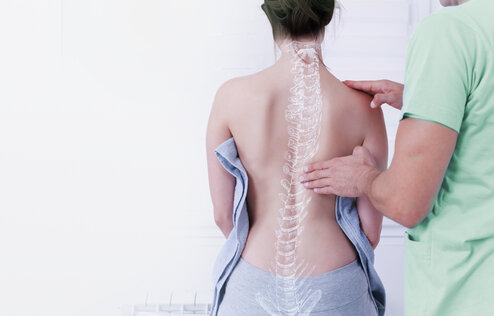MRI Spine in Bangkok, Thailand
Center : Spine Center

Chronic back pain not only causes discomfort, but it also interferes with daily activities. The common causes of back pain are prolonged periods of sitting, lifting heavy objects, and repetitive awkward movements. Sometimes, back pain can resolve itself with time. However, self-treatments are mostly ineffective for chronic back pain. The symptoms can indicate other serious spinal disorders, such as herniated disc pulposus, and degenerative spine disorders. Hence, Magnetic Resonance Imaging or MRI spine is recommended as an imaging tool to help diagnose spinal diseases. The main advantages of MRI of the spine are its effectiveness, precision, and practicality. Moreover, the procedure is painless and offers results in a short period of time.
Table of Contents
What is MRI
Magnetic Resonance Imaging (MRI) is a radiology imaging technique used for physical examination. The test uses radio waves and high-intensity magnetic fields to produce highly-detailed images. The internal organs or the structures of interest will be shown. MRI is comprehensive as it can be used to diagnose the pathologies of the brain, the heart, the bones, muscles, and even cancer. MRI technique helps doctors see the accurate state of the organs, allowing them to draw precise diagnoses. MRIs of the spine can also help people who suffer from back pain. Despite the widespread misunderstanding, MRI leaves no hazardous radiation in the body. The examination is painless and safe.
MRI and X-ray Differences
MRI and X-ray are one of the diagnostic imaging scans. Even though they help doctors diagnose the diseases, the indications for each of them are different. Here are the differences between MRI and X-ray.
X-ray
X-ray produces images by electromagnetic radiation that passes through the body. The different shades of black and white are varied, depending on the density of the organs and their conditions. The X-ray appears white if the radiation passes through the dense area, such as bones and joints. Whereas soft tissues and ligaments have less opacity, resulting in darker shades of gray.
Normally, X-ray is indicated to produce the images of your bones and joints, mostly the spine, the hip joints, the shoulder joints, etc. It can be used to determine the condition of bone fractures as well.
MRI
Magnetic Resonance Imaging or MRI, uses magnetic field and radio waves to create a highly-detailed image, highlighting the problems regarding soft tissues, muscles, and ligaments. MRI spine is used to detect disc, spinal cord, and spinal nerve problems. MRI is different from X-ray as it can show the conditions of the body more vivid regardless of the density of the tissues.
What will MRI spine detect?
MRI spine is considered to be one of the most comprehensive imaging techniques. The method is an additional examination performed after the physical examination has been done. It can detect a wide range of spine disorders, such as:
- Degenerative spine disorders: osteoporosis.
- The Herniated Disc
- Spinal stenosis
- Spondylolisthesis
- Spondylolysis
- Muscles or ligament injuries
Indications for MRI Spine
Despite its usefulness, The method of MRI on the spine may not be applied to every patient with back pain. The doctor will perform a physical examination to determine whether you need an additional imaging scan. However, the doctor may advise you have MRI spine if you have symptoms, such as:
- Severe neck pain.
- Chronic back pain that lasts for several weeks or months.
- Back pain with radiating pain into the legs, including numbness or tingling sensations. This applies to the case of neck pain with radiating pain into the arms as well.
- Muscle weakness in the arms, or the legs.
- Uncontrollable muscle twitching.
- Decreased sexual performance.
- Problems regarding urination and defecation.

MRI Spine Advantages
MRI spine offers you many advantages due to its practicality and usefulness. Some main advantages of MRI spines are:
- MRI offers you a quick result regarding abnormalities in your body.
- MRI images are highly-detailed with a clear distinction between tissues.
- MRI offers you a precise boundary of the impairment. This helps the doctor see the overall state of your body, allowing your doctor to determine the precise diagnosis and a proper treatment plan.
- MRI is painless and safe examination. No hazardous risks lingering in your body.
How to prepare yourself for an MRI spine?
Similar to other additional examinations, you may need to prepare yourself for an MRI. The method usually lasts about 30-40 minutes and requires no particular preparations. These are examples of how to get yourself ready before the examination:
- No makeup. Some cosmetics contain metal and foreign matters, which will disturb the quality of the image.
- No accessories, especially metal ones, such as earrings, jewelry, etc.
- In case you are wearing supporting equipment, for example, the waist band or the waist holder, the equipment needs to be removed first.
- You may have to fast for at least 4-6 hours before the examination, depending on your body condition and your doctor advice.
- Anesthesia may be needed for people with claustrophobia and those who are not cooperating willingly.
MRI Spine Potential Risks
Despite being considered generally safe, MRI spine can have potential risk as well. The MRI technologist will ask you some questions to determine whether you are eligible for an MRI. Here are some risks regarding the examination:
- Since MRI uses the strong magnet, people with certain implanted devices such as pacemakers or cochlear implants need to proceed with special precautions.
- Patients who have internal metal objects, such as surgical clips, plates, screws, or wires might not be eligible for an MRI.
- People with claustrophobia may need some precautions, such as anti-anxiety medications, before the examination.
- Pregnancy. It is suggested that you notify your doctor if you are pregnant, or suspected of being pregnant.
- Allergy. In some cases, the doctor may order a contrast dye to help produce images. If you are sensitive or allergic to contrast dye, notify the radiologist or your doctor.
- Other risks depending on your health conditions are also possible. It is recommended that you seek professional advice regarding the potential risks of the examination.
MRI Spine Procedure
MRI spine procedure usually lasts approximately 40 minutes to an hour. However, the procedure can be varied depending on your condition. Here are steps of how MRI spine is performed:
- You will be asked to remove any clothes or objects that may interfere with the procedure, such as earrings and jewelry. You may be given a gown to wear.
- If you are to have an examination with contrast, an IV line will be started in the arm or the hand. (You may experience a flushing sensation or feeling of coldness during the process, which usually lasts for a few moments.)
- You will lie down on a scan table that slides into a large circular tube opening of the machine. In some cases, pillows and straps may be used to prevent movements during the procedure.
- If you feel unwell, such as having breathing difficulties or heart palpitations, do inform the staff immediately.
- During the scanning process, you will hear a clicking noise as the magnetic field is created and pulses of radio waves are sent from the scanner.
- It is important that you remain very still during the examination, as any movement can cause distortion and affect the quality of the scan.
- At intervals, you may be instructed to hold your breath, or to not breathe, for a few seconds, depending on the body part being examined. Listen for guidance from your technologist.
- Once the scan is complete, the table will slide out of the scanner and you will be assisted off the table. (If an IV line was inserted for contrast administration, the line will be removed as well.)
Post MRI Spine Care
MRI spine is generally safe, but some people may experience uncomfortable feelings. Here are some tips on how to take care of yourself after the examination.
- Once the procedure is done, you should get up slowly from the scan table. This can prevent dizziness or lightheadedness.
- If any sedatives were taken for the procedure, you may be required to rest until the sedatives have worn off. It is suggested that you avoid driving as well.
- If contrast dye is used during your procedure, you may be monitored for a period of time for any allergic reactions or side effects.
- If you experience pain, redness, and/or swelling at the site of IV insertion, tell your doctor.
Aside from those issues, there is no special type of care required after the MRI spine. You can continue your daily activities as usual. However, it is possible in some cases that your doctor may suggest particular advice. This depends on your health condition.
MRI Spine Conclusion
MRI spine is generally painless and safe. The method offers you a quick result with high-detailed images, allowing your doctor to precisely diagnose the pathology. If you are now living in Bangkok, Nakornthon Hospital is recommended as one of the best hospitals offering spinal treatments. The MRI spine here, along with other innovative diagnostic technology, is used to precisely diagnose and help plan treatment. Nakornthon Hospital offers you a one-stop service to diagnose, treat, and prevent the recurrences of spinal conditions.
For more information, please contact:
- - Website : https://en.nakornthon.com
- - Facebook : Nakornthon Hospital - International Patient
- - Line : @nakornthoninter
- - Tel: 02-450-9999 (Available 24 hours)
Free Online Consultation
Article of Spine Center





